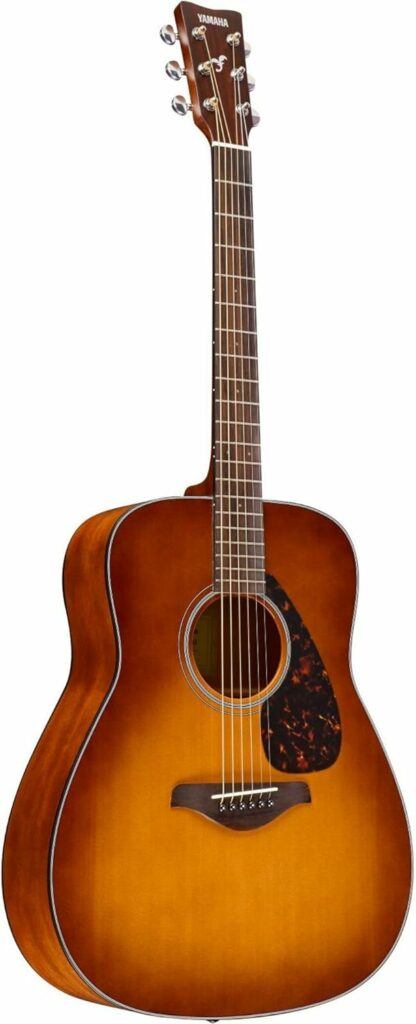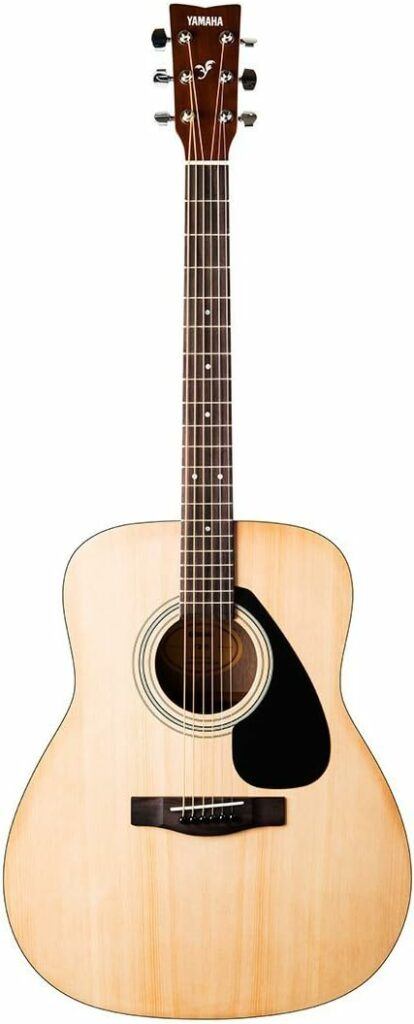The Yamaha FG800 has earned its reputation as one of the most reliable and popular acoustic guitars for beginners and intermediate players. Whether you’re just starting your musical journey or looking for an affordable upgrade, the FG800 offers a rich blend of sound quality, craftsmanship, and value. In this review, we’ll take a detailed look at the Yamaha FG800’s features, sound, playability, and overall performance.

Key Specifications
- Body Shape: Traditional Western Dreadnought
- Top Wood: Solid Sitka Spruce
- Back and Sides: Nato/Okoume
- Neck: Nato
- Fretboard: Rosewood
- Bridge: Rosewood
- Finish: Gloss
- Scale Length: 25.6 inches
- Number of Frets: 20
- Bracing: Scalloped Bracing
Build Quality and Design
One of the standout features of the Yamaha FG800 is its solid Sitka spruce top, a material commonly found in higher-end guitars. The spruce top is paired with Nato/Okoume back and sides, which might not have the same tonal richness as solid wood but still provide good durability and sound projection for the price. The guitar is finished with a gloss coating, giving it a professional and clean appearance while also protecting the wood.
The FG800 maintains a traditional dreadnought body shape, which is ideal for producing a rich, full-bodied sound with plenty of volume. The scalloped bracing inside the body further enhances the guitar’s resonance, ensuring that it projects well even when played acoustically without amplification.
The neck, crafted from Nato wood, is slim and comfortable to hold, making it suitable for both beginners and more experienced players. The rosewood fretboard offers a smooth playing surface, allowing your fingers to glide across the frets with ease.
Sound Quality
For an entry-level guitar, the Yamaha FG800 delivers impressive sound quality. The solid spruce top plays a crucial role in producing a lively, resonant tone with excellent clarity. This makes it ideal for various playing styles, including strumming, fingerpicking, and flatpicking. The guitar offers a well-balanced sound, with a crisp treble, strong mids, and a rich, punchy bass.
Due to the scalloped bracing, the FG800 provides increased resonance and enhanced low-end response, which adds depth and warmth to the overall tone. While some guitars in this price range can sound thin or dull, the FG800 offers a fuller sound that competes with guitars at much higher price points.
Playability and Comfort
The Yamaha FG800 is widely praised for its playability, which is crucial for beginner guitarists who need an instrument that’s easy to handle. The neck profile is slim and comfortable, making it easier to form chords and move across the fretboard. Additionally, the guitar’s action (the distance between the strings and fretboard) is typically set at a comfortable height, allowing for smooth playing without too much finger strain.
The dreadnought body can feel a little large for smaller players, but for most guitarists, it provides a nice balance of comfort and projection. The FG800’s weight is also moderate, so you won’t feel fatigued during long practice sessions or performances.
Durability and Build
Despite its affordability, the Yamaha FG800 is a durable and well-constructed guitar. The laminated back and sides help protect the instrument from cracking or warping over time, especially in changing climates. The gloss finish adds an extra layer of protection, ensuring that the guitar can withstand the rigors of frequent playing and transport.
Additionally, Yamaha is known for producing instruments that last, and the FG800 is no exception. Many players find that this guitar can hold up well for years with proper care and maintenance.
Who Is the Yamaha FG800 Best Suited For?
- Beginners: The Yamaha FG800 is an excellent guitar for beginners due to its affordability, durability, and easy playability. The solid spruce top and scalloped bracing also provide beginners with a quality sound experience right from the start.
- Intermediate Players: Those who have been playing for a while but are still on a budget will appreciate the sound quality and reliability of the FG800. It serves as a great upgrade from basic starter guitars.
- Home Players and Performers: The FG800 is great for home practice, casual performances, or even small gigs. Its volume and resonance make it suitable for acoustic playing, while its comfort and durability ensure that it performs well over time.
Pros and Cons
Pros:
- Solid Sitka Spruce Top: Provides rich, resonant tone uncommon in guitars at this price point.
- Scalloped Bracing: Enhances resonance and low-end response.
- Great Value: Offers excellent sound and build quality for an affordable price.
- Comfortable Playability: Slim neck and smooth fretboard make it easy for beginners to play.
- Durable Construction: Gloss finish and laminated back/sides ensure long-lasting durability.
Cons:
- Laminated Back and Sides: While durable, the sound quality of solid wood is superior.
- Dreadnought Size: May feel bulky for smaller players or those with smaller hands.
- No Electronics: The FG800 doesn’t come with built-in electronics, which may be a downside for those looking to amplify the sound without using external microphones.
Conclusion
The Yamaha FG800 stands out as one of the best options in the entry-level acoustic guitar market. With its solid spruce top, scalloped bracing, and impressive tonal quality, it offers much more than one might expect from a guitar at this price range. Whether you’re a beginner or an intermediate player, the FG800 provides a reliable and enjoyable playing experience that can grow with you as you develop your skills.
If you’re looking for a well-built, great-sounding guitar that doesn’t break the bank, the Yamaha FG800 is definitely worth considering. It’s a testament to Yamaha’s commitment to producing quality instruments that cater to musicians of all levels.


